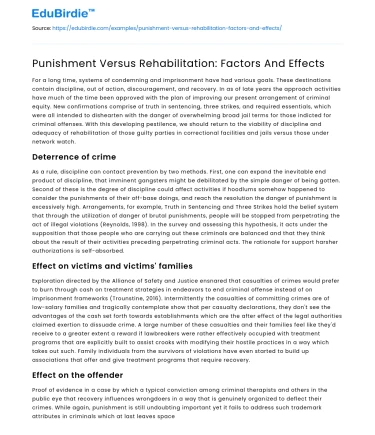Introduction
The debate over the efficacy and ethical implications of punishment versus rehabilitation in criminal justice systems has been ongoing for decades. At the heart of this discourse lies the question of how to best address criminal behavior while fostering societal safety and offender reform. Punishment, often seen as a deterrent and retributive measure, contrasts with rehabilitation, which focuses on reintegrating offenders into society as law-abiding citizens. This essay explores the various factors influencing the choice between punishment and rehabilitation, examines the effects of these approaches on offenders and society, and discusses the implications for policymaking. By analyzing real-world examples and drawing on academic research, this essay aims to shed light on the complex dynamics at play and propose a balanced perspective that incorporates both punitive and rehabilitative strategies.
Factors Influencing Punishment and Rehabilitation
Several factors influence the preference for punishment over rehabilitation or vice versa. Societal norms and cultural attitudes towards crime and justice play a significant role. In societies where retribution is valued, punitive measures are often favored. This is evidenced by the high incarceration rates in countries like the United States, where the "tough on crime" approach has dominated for decades (Garland, 2001). On the other hand, nations like Norway emphasize rehabilitation, reflected in their lower recidivism rates and more humane prison conditions (Barker, 2013). Economic considerations also impact this debate. Punitive systems often involve substantial costs associated with maintaining large prison populations, whereas rehabilitation programs, though initially costly, may reduce long-term expenses by lowering recidivism rates. Political factors further complicate the issue; policymakers may advocate for harsher penalties to gain public favor, despite evidence suggesting that rehabilitative approaches can be more effective in reducing crime.
Save your time!
We can take care of your essay
- Proper editing and formatting
- Free revision, title page, and bibliography
- Flexible prices and money-back guarantee
Moreover, the nature and severity of the crime committed can dictate the chosen approach. Violent crimes often elicit a more punitive response due to the perceived need for public safety and justice for victims. Conversely, non-violent offenders, particularly those with substance abuse issues, may benefit more from rehabilitation programs that address underlying causes of criminal behavior. A study by Andrews and Bonta (2010) found that cognitive-behavioral therapy and vocational training significantly reduced recidivism among non-violent offenders. These findings highlight the importance of tailoring interventions to individual circumstances rather than adopting a one-size-fits-all approach.
Effects of Punishment and Rehabilitation
The impact of punishment and rehabilitation on offenders and society is multifaceted. Punishment, particularly incarceration, may deter future criminal behavior through fear of consequences. However, research indicates that harsh penalties can have counterproductive effects, such as increasing recidivism due to the stigmatization and marginalization of former inmates (Cullen & Jonson, 2017). Prisons often serve as breeding grounds for criminal behavior, where inmates may form alliances with hardened criminals and leave the system more equipped for crime than when they entered.
Rehabilitation, by contrast, aims to address the root causes of criminal behavior and equip offenders with skills to reintegrate into society. Programs focusing on education, mental health, and substance abuse treatment have shown promise in reducing reoffending rates. For instance, the "Pathways Project" in the UK provides educational opportunities for inmates, significantly lowering recidivism rates among participants (Czerniawski, 2016). However, rehabilitation requires adequate resources and societal support, which may be lacking in systems geared towards punishment. Critics argue that investing heavily in rehabilitation may seem lenient and undermine justice for victims. Nonetheless, evidence suggests that a rehabilitative approach can enhance public safety in the long term by reducing the likelihood of reoffending.
Balancing Approaches and Addressing Counterarguments
In striving for a balanced justice system, it is crucial to address counterarguments that favor either extreme. Advocates of punishment often cite the need for retribution and deterrence. However, studies have shown that excessively harsh penalties do not necessarily lead to lower crime rates (Doob & Webster, 2003). Instead, they may exacerbate social inequalities and perpetuate cycles of crime. On the other hand, critics of rehabilitation argue that it may not be suitable for all offenders, particularly those with a high risk of reoffending. This perspective underscores the necessity of risk assessment tools to identify candidates for rehabilitation while ensuring public safety.
A hybrid approach that incorporates both punitive and rehabilitative elements may offer a more effective solution. For instance, restorative justice practices emphasize accountability and victim restitution while providing opportunities for offender rehabilitation. The success of such programs in New Zealand highlights their potential to reconcile conflicting objectives by prioritizing victim satisfaction and offender reform (Maxwell & Morris, 2006). By adopting a nuanced approach that considers the nature of the crime, the offender's background, and societal values, justice systems can better achieve their goals of reducing crime and fostering a safer society.
Conclusion
The ongoing debate between punishment and rehabilitation in justice systems underscores the complexity of addressing criminal behavior effectively. While punishment serves as a deterrent and a means of retribution, rehabilitation offers a path to reducing recidivism and fostering societal reintegration. This essay has highlighted the multifaceted factors influencing the choice between these approaches and their respective impacts on offenders and society. By acknowledging the limitations and strengths of both punishment and rehabilitation, policymakers can develop more balanced strategies that address the diverse needs of offenders and promote long-term public safety. Ultimately, the integration of punitive and rehabilitative measures, tailored to individual circumstances, may provide the most promising path toward a more equitable and effective justice system.






 Stuck on your essay?
Stuck on your essay?

